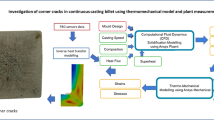Summary
In this paper an outline is given of a work carried out within a publicly supported project between the RWTH Aachen University and ThyssenKrupp Steel AG. The objective of the collaboration is to determine the hot temperature properties of different steel grades during solidification. These data will later be implemented into a FEM Simulation for continuous caster operated by the industrial partner. The calculated stress field of the slab provides an informative basis for the cracking susceptibility of the strand shell. Based on mathematical models on prediction of the solidification and microstructure parameters, the prediction of hot ductility is intended. In a first step the temperature distribution during solidification in a continuous casting mould is calculated and transferred to a microstructure simulation working on the basis of multiphase field modelling. The results are used to apply existing hot tearing criteria and determine the mechanical properties as ductility, critical strain or maximum strain rate. Additionally, combined solidification and hot tensile tests as well as microprobe analysis are carried out for evaluation of modelling results.
Zusammenfassung
Es wird ein Überblick gegeben über die Arbeit in einem von der DFG öffentlich geförderten Projekt zwischen der RWTH Aachen, ACCESS e.V. und der ThyssenKrupp Steel AG (TKS). Das Ziel der Zusammenarbeit ist die Berechnung mechanischer Kennwerte, insbesondere der Heißduktilität unterschiedlicher Stahlsorten während der Erstarrung. Die Kennwerte gehen in ein thermomechanisches FE-Modell der TKS ein und liefern somit wichtige Anhaltspunkte für die Rissempfindlichkeit der Strangschale während des Stranggießprozesses. Basierend auf mathematischen Modellen zur Berechung der Erstarrungs- und Mikrostrukturparameter, wird die Vorhersage der kritischen Parameter, die zu Rissbildung führen können, angestrebt. In einem ersten Schritt wird die Temperaturverteilung in der Kokille berechnet und an eine Mikrostruktursimulation, basierend auf einem Phasenfeld-Modell, gekoppelt. Es ist möglich, die Ergebnisse von Heißrisskriterien anzuwenden und somit mechanische Kennwerte wie Duktilität, kritische Dehnung und maximale Dehnrate zu bestimmen. Begleitend werden Erstarrungs- und Heißzugexperimente, metallographische Untersuchungen und Mikrosonden-Analysen zur Bewertung der Modellierungsergebnisse durchgeführt.
Similar content being viewed by others
References
Won, Y.M., T.-j. Yeo, D.J. Seol, and K.H. Oh: A new criterion for internal crack formation in continuously cast steels. Met. and Mat. Trans. B (2000), 779–794.
Clyne, T.W., M. Wolf, and W. Kurz: The effect of melt composition on solidification cracking of steel, with particular reference to continuous casting. Met. Trans. B (1982), 259–266.
Rappaz, M., J.-M. Drezet, and M. Gremaud: A new hot-tearing criterion. Met. and Mat. Trans. A (1999), 449–455.
Drezet, J.-M., M. Gremaud, R. Graf, and M. Gäumann: A New Hot Tearing Criterion for Steel. 5th European Continuous Casting Conf. 2003, Birmingham, Proc. pp. 755–763.
Grasso P.-D., J.-M. Drezet, and M. Rappaz: Hot tear formation and coalescence observations in organic alloys. The Journal of the Minerals, Metals & Materials Society (JOM) 2002, http://www.tms.org/pubs/journals/JOM/jom.html.
Wang, N., S. Mokadem, M. Rappaz, and W. Kurz: Solidification cracking of superalloy single- and bi-crystals. Acta Materialia (2004), 3173–3182.
Rappaz, M., A. Jacot, and W.J. Boettinger: Last-stage solidification of alloys: theoretical model of dendrite-arm and grain coalescence. Met. Trans. A (2003), 467–479.
Steinbach, I., F. Pezolla, B. Nestler, M. Seeßelberg, R. Prieler, and G.J. Schmitz: Physica D 94 (1996), 135.
Tiaden, J., B. Nestler, H.J. Diepers, and I. Steinbach: Physica D 115 (1998), 73.
Steinbach, I., and F. Pezolla: Physica D 134 (1999), 385.
Eiken, J., B. Böttger, and I. Steinbach, Phys. Rev. E73 (2006).
Böttger, B., J. Eiken, and I. Steinbach: Acta. Mater. 54 (2006), 2697.
Stratemeier, S., and D. Senk: Berechnungen und Experimente zur Heißduktilität von Stählen. Proc. of 21st ASK, Aachener Stahlkolloquium (2006), 247–256.
Yamanaka, A., K. Nakajima, and K. Okamura: Critical strain for internal crack formation in continuous casting. Ironmaking&Steelmaking 2 (1995), 508–512.
Senk, D., B. Engl, O. Siemon, and G. Stebner: Investigation of solidification and microsegregation of near-net-shape cast carbon steel. Steel Research (1999), 368–372.
Senk, D., H. Emmerich, J. Rezende, R. Siquieri: Estimation of segregation in iron-manganese steels. Advanced Engineering Materials 9 (2007), 695–702.
Author information
Authors and Affiliations
Rights and permissions
About this article
Cite this article
Stratemeier, S., Senk, D., Böttger, B. et al. Simulation and Modelling of Hot Ductility for Different Steel Grades. Berg Huettenmaenn Monatsh 152, 361–366 (2007). https://doi.org/10.1007/s00501-007-0329-2
Issue Date:
DOI: https://doi.org/10.1007/s00501-007-0329-2




